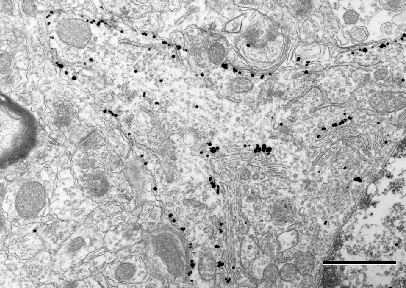'A very reliable pre-embedding immunogold method'
Dr. Susan Cheng and co-workers at NINDS have refined their pre-embedding
procedure for the most uniform, consistent and reliable pre-embedding
labeling, using Nanogold®-Fab' and HQ Silver.
What our users have found with this protocol:
- Higher density gold labeling than with other methods.
- Very high specificity.
- Maximum resolution.
This procedure has been described by Tanner and co-workers, and is reported to give significantly higher densities of silver-enhanced gold nanoparticles than other methods. An example of the results is shown below:

Nanogold®:-Fab' goat anti-rabbit IgG (Catalog # 2004) labeling the K+ channel Kv2.1 subunit in rat brain, followed by HQ Silver (Catalog # 2012) enhancement. Note high density and specificity of immunostaining, even elucidating subunit localization to cytoplasmic side of cell membrane and outer stacks of the Golgi; axons and terminals are clearly negative. Work done by J. Du, J.-H. Tao-Cheng, P. Zerfas, and C. J. McBain, NIH. See Neuroscience, 84, 37-48 (1998). Bar = 1 micron.
Materials and Reagents
Sodium phosphate buffer: 0.1 M sodium phosphate, pH adjusted to 7.4.
- Phosphate-buffered saline (PBS) buffer: 0.02 M sodium phosphate buffer with 0.15 M sodium chloride, pH adjusted to 7.4.
- Phosphate-buffered saline (PBS) buffer: 0.02 M sodium phosphate buffer with 0.15 M sodium chloride, pH adjusted to 7.4, containing (a) 5 % bovine serum albumin and 0.05 to 0.1 % sodium azide; and (b) 1% goat serum and 0.1% NaN3 for 3-4 X 5 min
- Glutaraldehyde and paraformaldehyde.
- HQ Silver reagent (Nanoprobes).
- Deionized or distilled water.
Protocol
- Fix for ~45 minutes (for monolayer cultures) with one of the following: (1) 4% paraformaldehyde in 0.1M sodium phosphate buffer, pH 7.4, or (2) 2% paraformaldehyde with 0.05% - 0.1% glutaraldehyde in 0.1 M sodium phosphate buffer, pH 7.4.
- Wash with 0. 1 M sodium phosphate buffer, pH 7.4, 3 x 5 min each.
- Blocking and permeabilize the cells with PBS with 5 % goat serum, 0.1% sodium azide and 0.1% Saponin for 1 hour.
- Incubate with primary antibody made in PBS with 5% normal goat serum, 0.1% saponin and 0.1% sodium azide for 1 hour at room temp.
- Wash with PBS with 1% goat serum and 0.1% sodium azide for 3-4 x 5 min.
- Incubate with Nanogold -labeled Fab' anti-rabbit or mouse (depending on the primary antibody) secondary antibody conjugate (4 l) in 1 ml of PBS with 1% goat serum and 0.1% sodium azide for 1 hr, room temp.
- Wash with PBS containing 1% goat serum with 0.1% sodium azide, once, then PBS, twice.
- Fix with 2% glutaraldehyde in PBS for 30 minutes.
- Wash 3 times in PBS. Store overnight.
Next day:
- Wash with water thoroughly.
- Perform silver enhancement (HQ Silver enhancement kit, Nanoprobes, NY).
- Wash in water. Check under LM carefully; only process the promising specimens for EM.
- Wash in 0.1M phosphate buffer, pH 7.4.
- 0.2% OsO4 in 0,1 M phosphate buffer for 30 minutes.
- Wash, stain with uranyl acetate, dehydrate in ethanol, and embed.
References
- Tanner, V. A., Ploug, T., and Tao-Cheng, J.-H. Subcellular localization of SV2 and other secretory vesicle components in PC12 cells by an efficient method of preembedding EM Immunocytochemistry for cell cultures. J. Histochem. Cytochem., 44, 1481-1488 (1996).
- Du, J.; Tao-Cheng, J.-H.; Zerfas, P., and McBain, C. J. The K+ channel, Kv2.1, is apposed to astrocytic processes and is associated with inhibitory postsynaptic membranes in hippocampal and cortical principal neurons and inhibitory interneurons. Neuroscience, 84, 37-48 (1998).
See also
|